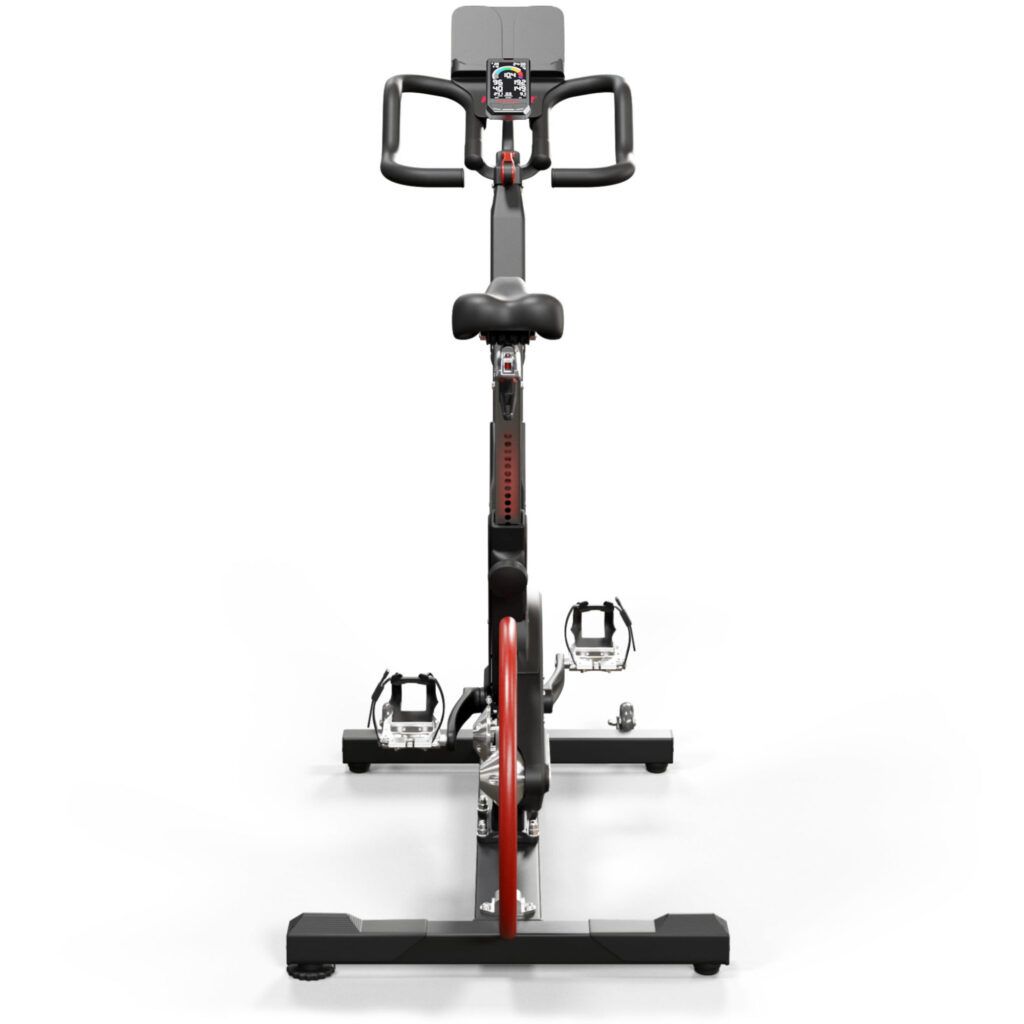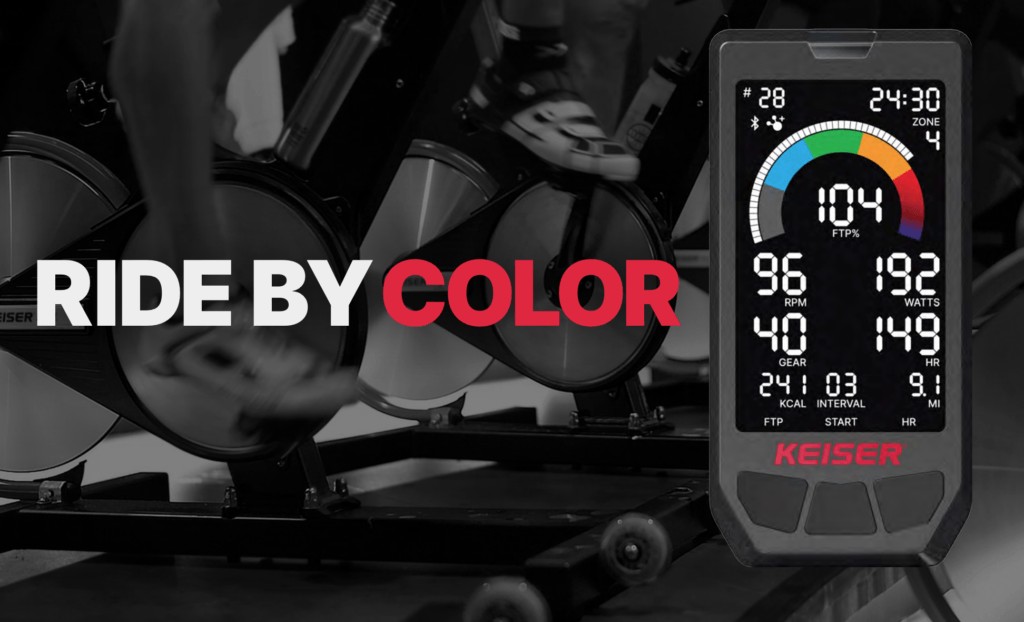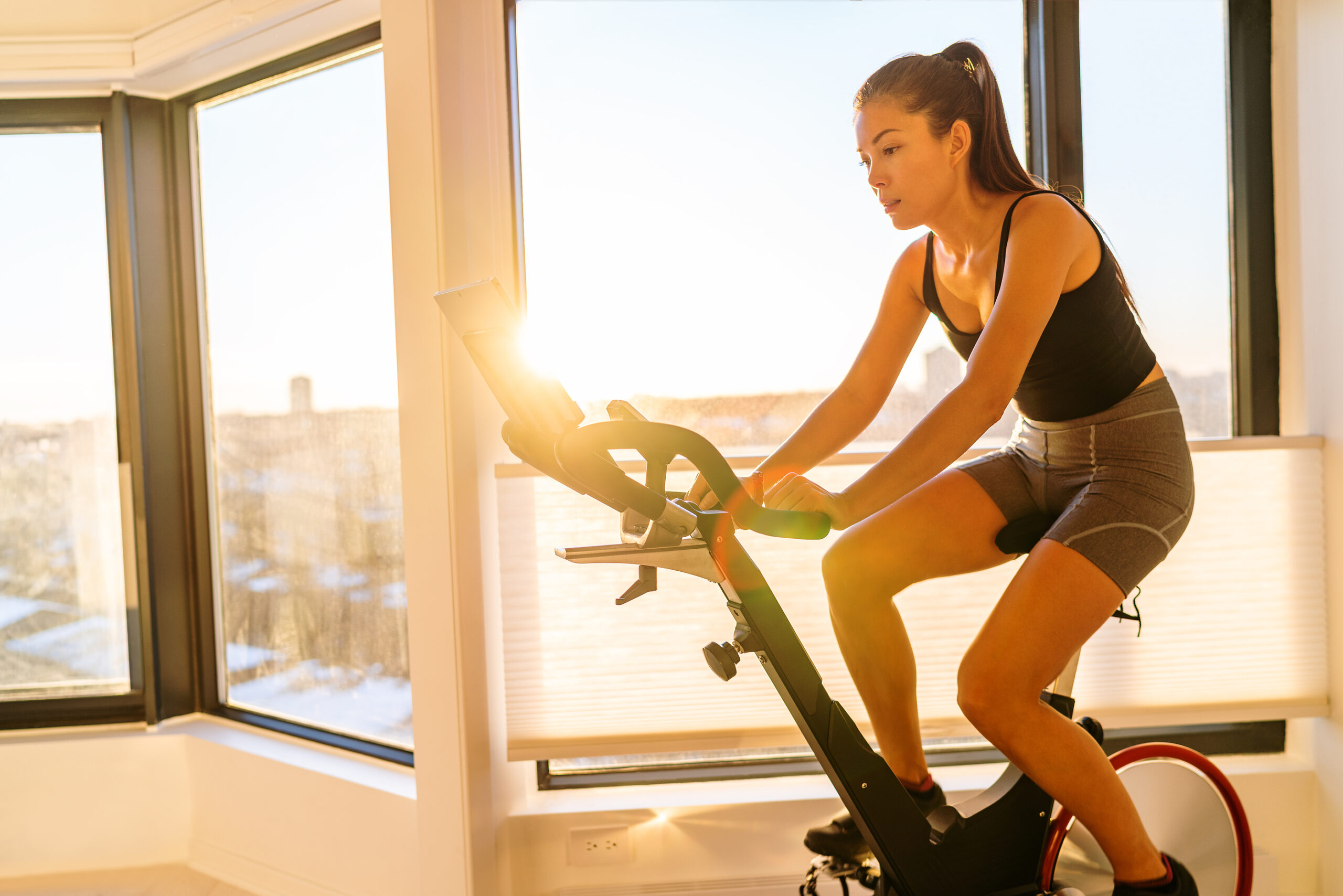Keiser’s revamped their cardio lineup and is now offering a couple of additional indoor cycling options, known as the M3i Studio and M3i Studio Plus.
The Studio Plus is their highest-end cycle to date and as such, comes with a few additional upgrades.
Like previous models, the Studio Plus still utilizes a fast-spinning, lightweight flywheel and a buttery-smooth magnetic resistance system.
But the upgraded model now comes with 72 resistance levels for even more control over workouts and an updated, self-generating console for a better user experience.
Otherwise, the M3i Studio Plus comes with all the same quality craftsmanship that made the original M3i one of the best indoor cycles in the world.
If you’re searching for an elite indoor cycle, Keiser’s M3i Studio Plus is a great choice, but at roughly $3k, it’s probably not an investment you’ll wanna make lightly.
Before you buy, you’ll want to make sure you know everything about this bike, including its top competitors, to be sure this is truly the right bike.
Fortunately, that’s what I’m here to help with.
In this review, I’ll go over everything the M3i Studio Plus does and doesn’t have going for it, but I’ll also compare it to some of the other top cycles in its price range.
I’ll even toss in a quick comparison to Keiser’s other new model, the M3i Studio, so you can see the key differences between ’em.
After reading, you’ll know wether or not the M3i Studio Plus is the right bike for your home.
With the M3i Studio Plus, Keiser took their classic M3i, gave it 72 resistance levels, and added an updated console. The result is an elite cycle with an even better overall user experience.
Keiser’s M3i Studio Plus Indoor Bike
Keiser’s a producer of both residential and commercial equipment and they’re known for creating some of the most sophisticated fitness equipment out there.
In fact, you’ll find Keiser equipment in a lot of professional sports teams training rooms, as they’re a favorite brand for professional athletes.
Anyway, when it comes to their home fitness lineup, they’ve only got a handful or so of cardio machines to choose from.
Their ellipticals and steppers are great, but it’s their indoor cycles that most of us are familiar with.
The M3i Studio Plus we’re here to go over now has replaced their older M3i, which was a beloved cycle, known for its quality components and incredible performance.
They’ve also recently added the M3i Studio (which we’ll be going over in a bit) and they still continue to offer the M3, which is still a great cycle in its own right.
Let’s start this review off by taking a look at how the M3i Studio Plus’ performs.
Pros
- Lightweight, rear-mounted flywheel
- 1:11 gear ratio
- 72 resistance gears
- Self-generating power source
- Belt drive
- V-shaped frame
- 350 lb weight limit
- Studio Display console
- Bluetooth, ANT+ compatible
- Lifetime subscription to Keiser’s fitness app
- Floor mat included
- Tool bag included
- Media tray
- Fully-adjustable seat
- Fully-adjustable handlebars
- Dual-compatible pedals
- Fits riders up to 7′ tall
- Amazing reputation
Cons
- Frame warranty could be a little longer
- No water bottle holder
- No dumbbell rack
- Pricey
Resistance
When it comes to indoor cycles, we’re often talking about how heavy flywheels are preferred because they can build more momentum and provide smoother feels and all that.
This is all true in most cases, but there are cycles, like the Studio Plus, that are designed specifically for lightweight flywheels.
Instead of relying on sheer mass, Keiser instead designed their flywheels to spin really fast, allowing them to build momentum without having to be extra heavy.
In fact, Keiser’s M3i Studio Plus uses a 1:11 gear ratio, meaning that the flywheel rotates 11x for every full rotation of the pedals.
That means the flywheel is doing a lot of spinning during your workouts.
This allows Keiser to create a really smooth experience without having to add a lot of weight to the flywheel.
The Studio Plus, like all of Keiser’s other indoor cycles, uses only an 8 lb flywheel, yet still provides one of the smoothest pedaling motions you’ll ever find.
Having a lightweight flywheel also comes with the added perk of putting lest stress on your knees when starting from a stopped position and slowing down.
The Studio Plus uses the same flywheel found on the older M3i, but Keiser did upgrade the resistance system with this newer model.
Yup, with 72 gears, the Studio Plus comes with a lot more resistance control (the older M3i came with 24 gears).
Having more resistance levels is always a good thing to me because it means you can make smaller resistance adjustments during workouts, giving you the ability to really fine tune your intensity.
And of course Keiser uses high-end belt drives with all their cycles, so no issues there.
The combination of a fast-spinning flywheel and sophisticated magnetic resistance system makes for a smooth, quiet pedaling experience that can compete with any indoor cycle out there.
Overall, the Studio Plus scores highly in the resistance department – I love that it uses a lightweight, fast-spinning flywheel and I think it was smart of Keiser to offer more control over the resistance.
Frame
The Studio Plus uses the same frame that was used on the older M3i model.
This means this newer model comes with a stable, V-shaped frame that can accommodate riders of all sizes.
More specifically, the Studio Plus should be able to fit most riders between 4’10” and 7′ tall, which is impressive for any exercise bike.
The fully adjustable seat and handlebars certainly help, but the real magic is in that V-shaped design that brings the handlebars and seat farther apart as you elevate the height of either.
This combination allows folks of all shapes and sizes the ability to find a comfortable riding position.
Like the M3i, the M3i Studio Plus only comes with an assembled weight of around 92 lb, which is lightweight for a cycle of this caliber.
But keep in mind, this cycle doesn’t have the added weight a massive flywheel offers, so this lower assembled weight doesn’t mean this bike has a flimsy frame.
Quite the opposite.
The Studio Plus comes with a sleek frame that can safely handle folks weighing up to 350 lb – again, letting riders of all shapes and sizes safely use it.
Overall, the Studio Plus scores highly with its sturdy, V-shaped frame that can hold users of all heights and sizes.

Warranty
Keiser covers their M3i Studio Plus with the following home warranty:
- 3 year frame
- 3 year parts
- 90 day wearable items
So, Keiser offers a 3 year all inclusive warranty, that basically covers everything on the bike, except for the wearable items (pedal cage, pedal strap, saddle, etc).
Three years on parts is actually really good, even for an indoor cycle in this price range, but 3 years for the frame is a bit short.
For the sake of comparison, ICG’s similarly priced cycles come with 5 year frame and 3 year parts warranties.
Overall, not a bad warranty, but there’s room for improvement when it comes to the frame coverage.

Features
Keiser’s M3i Studio Plus comes with the following included features:
Studio Display console- Keiser gave their console an overhaul and the result is a brightly-lit, colorful display with more interactive features. This new console comes with color-coded zones that can be used with FTP (watt-based) or heart rate training, as well as MET tracking during workouts. The new console is also bluetooth and ANT+ compatible with fitness apps and heart rate monitors, so you can connect to any device you like. And since this console is compatible with most projection systems, the Studio Plus is designed to work seamlessly in cycling studios as well. Overall, a sophisticated console that makes it easy to track all your metrics.
Self-generating power- this new console is also self-generating, meaning that you power it as you ride. No need for batteries or power cords. This also means you don’t have to worry about placing it near an outlet, which is nice.
Lifetime The Ride® subscription- this is Keiser’s on-demand workout platform, which gives you access to instructor-led workouts and all that jazz. It usually costs $6.99/month, but Keiser will hook you up with a free lifetime subscription with purchase of the Studio Plus.
Fully-adjustable seat- as mentioned earlier, this bike comes with a fully adjustable seat, meaning you can adjust the height and fore/aft positions easily to find the right fit.
Fully-adjustable handlebars- the handlebars are also fully adjustable and the Studio Pro also comes with upgraded, rounded handles for more grip options and added comfort.
Dual-compatible pedals- the Studio Pro’s pedals come with a toe cage on one side and SPD-compatible clips on the other, so you can use riding cleats or sneakers during rides.
Tool kit- Keiser includes a rather impressive tool kit with purchase, ensuring you have all the necessary tools to assemble and maintain your new cycle.
Media tray- they also toss in a media tray that can hold your phone, tablet, or any reading materials you might need during workouts.
Floor mat- there’s also an included mat to help protect your flooring (very kind of Keiser to include one).
Price & Comps
As I’m writing this review, Keiser has the M3i Studio Pro listed for $3,220, so we’ll use this price range to find our comps.
The first comp that comes to mind is ICG’s IC6 Indoor Cycle, which usually goes for around $3200.
The IC6 is another elite cycle from a great brand and it has a lot in common with the M3i Studio Pro.
The IC6 uses a rear-mounted, lightweight flywheel (7.6 lb) with a 1:10 gear ratio for that fast-spinning, lightweight flywheel experience as well.
The IC6 also comes with a fully-adjustable seat, fully adjustable handlebars, dual-compatible pedals, and a Coach by Color console which is similar to Keiser’s.
The IC6 comes with a slightly better warranty (5 year frame) and is quite a bit bulkier too, coming with an assembled weight of roughly 112 lb.
There’s also Octane’s Surge Cycle, which normally goes for around $2,800.
This is another high-end, rear-mounted flywheel cycle and it comes with 20 magnetic resistance levels, a self-generated power source, dual-compatible pedals, and a heavy-duty frame.
The Surge’s warranty is a little better (5 year frame), but Keiser’s console is more sophisticated.
Finally, in this price range you’ve got bikes like NordicTrack’s S27i (or the Peloton Bike+), which come with large, touchscreen consoles for streaming instructor-led workouts.
The S27i uses a heavy, front-mounted flywheel, so it’s not really in the same class, but I thought it was worth mentioning due to the price range (it usually goes for around $2500).
To be honest though, the S27i (or Peloton) isn’t in the same league as the M3i Studio Plus.
Overall, the Studio Plus isn’t cheap, but it can easily hang with any cycle in this price range.
Keiser M3i Studio Plus vs M3i Studio
| M3i Studio Plus | M3i Studio | |
|---|---|---|
| Resistance gears | 72 | 72 |
| Studio Display console? | Yes | Yes |
| Handlebars | Rounded, fully-adjustable | Straight, height adjustable only |
| User height | 4'10" - 7' | 5'0 - 6'2" |
Before I wrap things up, I also want to provide a quick comparison to Keiser’s other new addition, the M3i Studio.
The M3i Studio Plus and M3i Studio are identical in terms of performance – they both come with the same 72-gear magnetic resistance system, same flywheel, same frame, and same specs.
They also both come with the same Studio Display console.
The only real difference between them is with regards to the handlebars: the Studio Plus comes with the upgraded curved handles that are fully adjustable, while the Studio comes with the older, straight handles that are only height adjustable.
That’s it, upgraded handlebars.
The price difference between these 2 bikes is around $120, so apparently that’s what the fully-adjustable handlebars are worth these days.
According to Keiser, the M3i Studio can only handle users upwards of around 6’2″ or so, what with the handles not being fully adjustable and all.
Personally, I’d expect the Studio to still be able to handle folks quite a bit taller since the handles are still height adjustable, but even so, taller folks might want to go all-in with the Studio Pro just to make sure.
Anyway, are the upgraded handles worth the extra cost?
That’s a personal question, but if you ask me, I’d say yea – if you’re going in with a $3k bike, what’s another $100?
Final Thoughts
Ok, I think that about does it for the M3i Studio Plus.
With this upgraded model, Keiser essentially just took their older M3i and gave its console a facelift without messing with the performance specs.
Hey, if it ain’t broke, don’t fix it (if you’re familiar with the older model, you know exactly what I’m talking about here).
With 72 resistance gears, the Studio Plus offers a lot more control over the resistance, but otherwise, the Studio Plus performs identically to the classic model.
Same lightweight flywheel, same 1:11 gear ratio, same frame.
The updated console offers some nice features too, so I think it was smart for Keiser to do this.
And I think it’s very cool of Keiser to include a lifetime membership to their streaming app for free (I wonder how long this offer will last?)
With regards to the M3i Studio, the Plus comes with upgraded handlebars, but otherwise, the 2 cycles are identical.
There’s not much to complain about with the Studio Plus, but the frame warranty could be longer and it would be nice if they included a water bottle holder and maybe a dumbbell rack.
But these are small complaints compared to how much awesomeness this cycle has to offer.
It’s true, the price is a bit steep, but based on the comps mentioned above, I’d say it’s priced in the right ballpark.
All things considered, Keiser’s M3i Studio Plus might just be the best home indoor cycle on the market at the moment.
Highly recommended.






